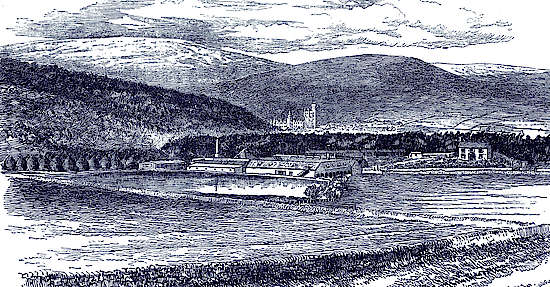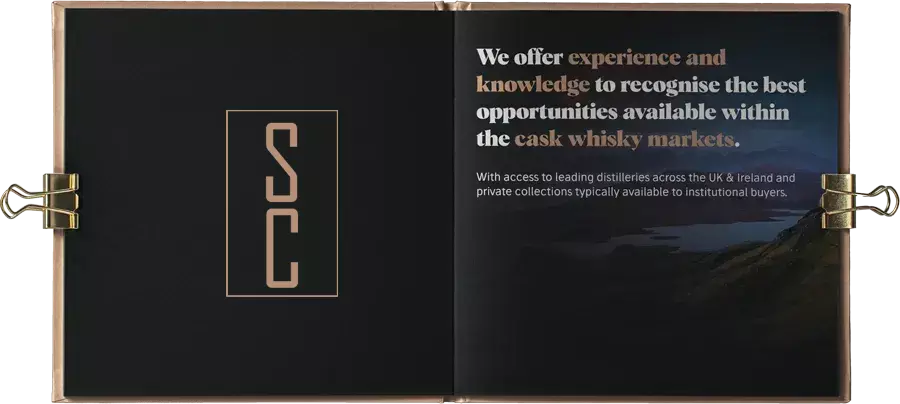In the middle of the 1880s Alfred Barnard visited the Malt Whisky distilleries of Scotland and described them in his book 'The Whisky Distilleries of the United Kingdom'. From today's perspective the old world seems idyllic. Many small Whisky distilleries handcrafted the Malt Whisky Alfred Barnard and we appreciate so much.
But already during that time great changes came about. The beginning industrialisation reached also the remotest valley in the Scottish Highlands. The tax on alcohol and Whisky had been established long before, and the law allowed only licenced distilleries to produce Whisky. The time of illicit distilling was over.

In the middle of the 1880s Alfred Barnard visited the Malt Whisky distilleries of Scotland and described them in his book 'The Whisky Distilleries of the United Kingdom'. From today's perspective the old world seems idyllic. Many small Whisky distilleries handcrafted the Malt Whisky Alfred Barnard and we appreciate so much.
1. Industrialisation
But already during that time great changes came about. The beginning industrialisation reached also the remotest valley in the Scottish Highlands. The tax on alcohol and Whisky had been established long before, and the law allowed only licenced distilleries to produce Whisky. The time of illicit distilling was over.
At the end of the 19th century, the concentration process that had been triggered by licencing was continued. The rural farms with distillation as a sideline became economically independent companies. New train routes reached the farthest corners of Scotland, and the Malt Whisky could be easily transported into the cities. Here it was predominantly used for blending with Grain Whisky, which had been introduced a few decades before with the column stills. During this period of boom, important Blended Whisky brands such as Dewar's and Haig emerged. Single Malt Whisky led a shadowy existence and was only appreciated by the Scots themselves and as 'spice' for the Blended Whiskies, which were meanwhile sold worldwide.
The big success of the Blended Whiskies made the corporations grow until 1914. The brands and their taste were consolidated. Since Malt Whiskies are the most important and taste-defining ingredient of the Blends, the corporations became dependent on the supply of Malt Whiskies. They began to secure their 'Whisky sources' and bought preferably the distilleries from which they already bought casks for their Blends. They paid in a currency that was as valuable for the buyers as it was cheap for the sellers. Stocks! Consistent and laborious work in the barren highlands was rewarded with shares of the corporations.
A world economy in the narrow sense was not yet really existent at the turn of the century. The Commonwealth with the British crown colonies and the independent United States were the preferred markets for Whisky, with America being even more important since only the small, ruling upper class of the colonies could afford Whisky.
2. World War I
Since the whole industry depended on only few countries, World War I led to a drastic decline of the Whisky production. The smuggling of alcohol into the USA could compensate for a small part during prohibition (1919-33), but the production didn't reach pre-war levels anymore. This led to serious problems for the Whisky companies.
High debt and the first closures subsequently shocked the Scots. The recovery came with the end of prohibition in 1933, when Britain was allowed to pay its war debts to the USA in Whisky. The Distiller’s Company Ltd. became the uncrowned winner and could take over many companies and distilleries. They have now evolved into the biggest spirits corporation of the world, Diageo.
3. Concentration
After the war the concentration happened even faster, and out of more than two dozen big companies only eight are left today. The global expansion, led by the USA and Britain, fuelled competition, so the companies either merged or were taken over by the big players.
For 20 years the big corporations haven't been focusing on Whisky alone anymore but are now operating on the entire spirits market. The cost advantages are too big when you can distribute Vodka, Gin, Cognac and Rum beside Whisky using the same infrastructure.
But the takeover of Seagram's and Allied Domecq by Diageo and Pernod Ricard showed that the takeover business has almost come to a standstill. The competition guardians in the USA and Europe only approved of the takeovers under strict conditions. The concentration is already so high that there are fears that one company could achieve a dominant position.
This allowed the corporations in pursuit to catch up. The new star in the Whisky sky is the French company Pernod Ricard, which challenged the long-established Anglo-Saxon companies by taking over Chivas Brothers and Glen Grant. The American competitors are also not far away. Jim Beam, Jack Daniel's and Bacardi are catching up fast. But also Asia plays a big role now. Jim Beam first took over Whyte & Mackay, only to be taken over by Suntory, which thereby became the global number 3.
While the corporations pondered on Asian growth rates and the relations between Whisky, Rum, Vodka, Cognac and Gin, a development was set in motion from which we connoisseurs benefit today. At first unnoticed by the big players, Glenfiddich sold their Whisky on the duty-free market. The success was so big in the 1980s that the malt soon followed the travellers into the local supermarkets. Until the big players woke up, Wm. Grant & Sons, the owner of Glenfiddich, had occupied the market. Today Glenfiddich is by far Single Malt Whisky market leader, and even Diageo admits that the sales figures of the 'Classic Malts of Scotland' don't come near those of Glenfiddich.
But the giants have awoken and develop the Single Malt market. One bottling follows the other, and the big players of the industry empty their warehouses for us.
Who would have thought ten years ago that we would see original bottlings of Port Ellen or Ladyburn again? Almost all the corporations are stock companies, and the shareholders demand short-term successes. If there was a market, some people would perhaps even sell their mother-in-law.
But in the wake of Glenfiddich, other smaller Scotch Whisky companies seized their chances. And they seized them well. InverHouse and Edrington got a significant share of the cake with several hundred millions of dollars in sales. While the billion dollar corporations used their cost advantages in distribution, smaller Whisky companies could make their profit with valuable special bottlings.
When big players don't play well, they must change the game. Jim Beam, showing excellent growth rates in mass business, failed in Scotland. The takeover of Invergordon and Whyte & Mackay never really took off. Why so? It's an idle question. After a management buyout they were both bought by United Spirits from India. But they also had no luck, and in 2014 Diageo acquired the majority of shares from the Indians.
4. Newcomers
But the popularity of Malt Whisky opened up new possibilities for small companies. Privately-owned distilleries can survive and develop. Even start-up Malt Whisky distilleries such as Arran or Kilchoman have a chance. The market is difficult, and often fresh capital must be injected. But if they make it in only a few months, like Bruichladdich, they can reap the fruits of their hard work. Even if they only sell to a corporation such as Remy Cointreau for a top price of almost 100 million dollars, like Bruichladdich did.
Considering the successes, it's not justified to call the big players job killers. Where would all the Malt Whiskies be, compared to Cognac or Rum, if it wasn't for the success of the Blends, which fuelled the demand for Malts? Wouldn't many more Malt Whisky distilleries have had to be closed without this support?
The independent bottlers played their part in it, too. But that's a story we want to tell some other time.
